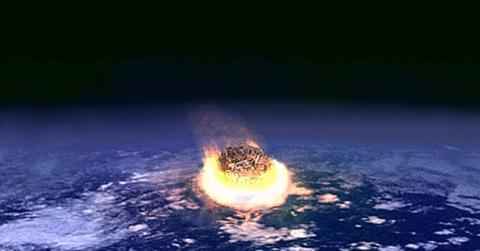66-Million-Year-Old Mystery Solved? Study Reveals Exactly What Likely Wiped Out Dinosaurs

A new study suggests the dinosaurs were wiped from the planet by a "global winter" caused by dust released into the atmosphere when an asteroid smashed into the Earth, as seen in this artist conception.
A new study aims to clarify clouded knowledge about what killed the dinosaurs 66 million years ago.
The research says the prehistoric beasts were likely wiped out by a massive plume of dust that caused the Earth's temperature to plummet, Knewz.com reported.
When an asteroid larger than Mount Everest slammed into what is now the Yucatán Peninsula, it triggered a series of cataclysmic events, like global wildfires, earthquakes, mega-tsunamis, and volcanic eruptions.
At the center of some scientific debate is what exactly caused a "global winter" in the following years, where temperatures fell 60 degrees, wiping out three-quarters of the Earth's species.
The leading theory has been that soot and sulphur from the wildfires blocked out sunlight for years, first killing plants and then the animals who rely on them to survive.
However, the new study published on Oct. 30 in the peer-reviewed scientific journal Nature Geoscience suggests a different theory: that the asteroid kicked up a flurry of rock dust containing "climate-active" particles that lingered in the atmosphere, working over time to dramatically lower temperatures.
Researchers in Belgium used simulations of silicate dust and sulfur, as well as soot from wildfires, to closely examine the short-term global environmental consequences of the asteroid impact, in an effort to identify the "killing mechanisms" of the mass extinction.
The findings revealed that, in contrast to previous work, the dust plume "plays a large part" in the global crisis, according to the study.
Never miss a story — sign up for the Front Page Detectives newsletter. Be on the scene the moment news breaks.
"Ultimately, the study finds that the global winter triggered by the dust plume, combined with the effects of sulfur and soot, probably led to a disastrous collapse of primary productivity in land and ocean realms, steering the global mass extinction," the study said.
The study's simulations were consistent with how scientists believe the events unfolded following the asteroid impact.
"Species that were not adapted to survive the dark, cold and food-deprived conditions for almost two years would have experienced massive extinctions," the study said.
The study was published less than a week after Knewz.com reported dinosaur footprints dating back 125 million years were found in a coastal part of the United Kingdom. Scientists believe the fossilized footprints belonged to a Mantellisaurus, a 23-foot dinosaur that lived during the Early Cretaceous period.
Become a Front Page Detective
Sign up to receive breaking
Front Page Detectives
news and exclusive investigations.
